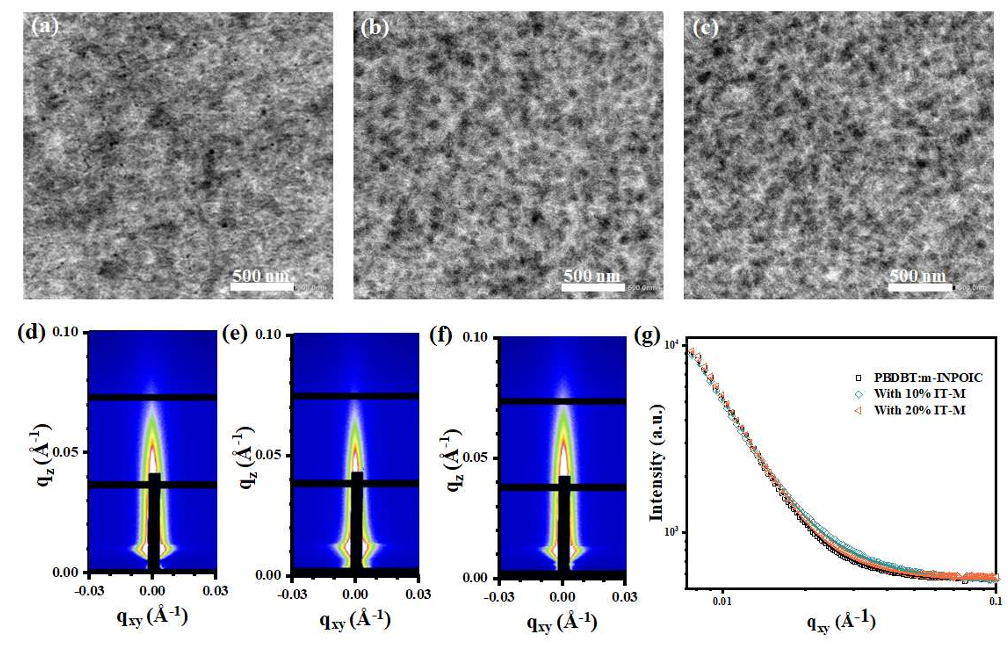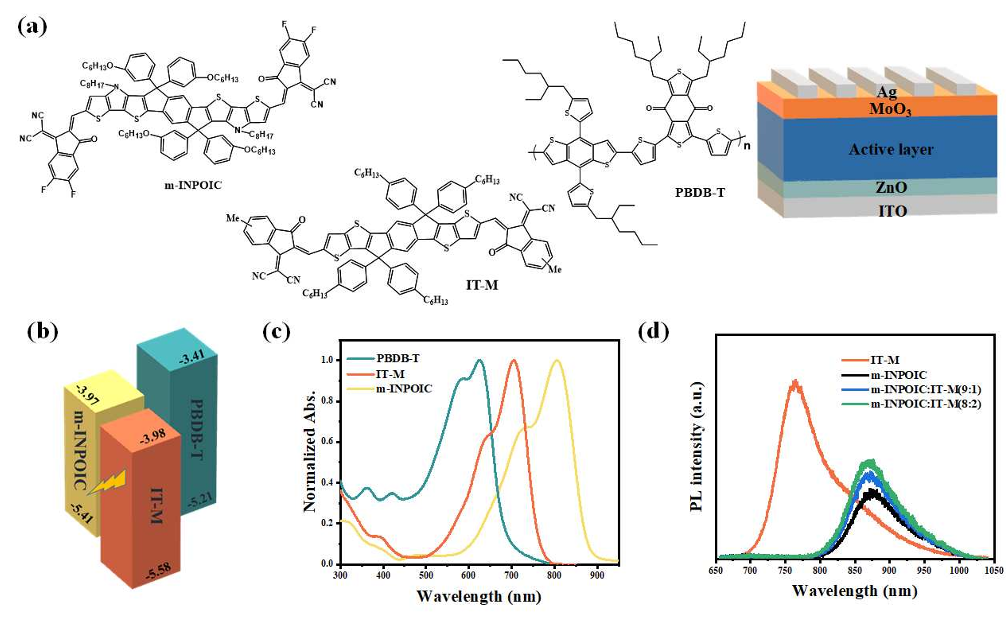
This is a repository copy of 13.9% efficiency ternary nonfullerene organic solar cells
featuring low-structural order.
White Rose Research Online URL for this paper:
http://eprints.whiterose.ac.uk/156045/
Version: Accepted Version
Article:
Du, B., Geng, R., Li, W. et al. (11 more authors) (2019) 13.9% efficiency ternary
nonfullerene organic solar cells featuring low-structural order. ACS Energy Letters, 4 (10).
pp. 2378-2385. ISSN 2380-8195
https://doi.org/10.1021/acsenergylett.9b01630
This document is the Accepted Manuscript version of a Published Work that appeared in
final form in ACS Energy Letters, copyright © American Chemical Society after peer review
and technical editing by the publisher. To access the final edited and published work see
https://doi.org/10.1021/acsenergylett.9b01630
eprints@whiterose.ac.uk
https://eprints.whiterose.ac.uk/
Reuse
Items deposited in White Rose Research Online are protected by copyright, with all rights reserved unless
indicated otherwise. They may be downloaded and/or printed for private study, or other acts as permitted by
national copyright laws. The publisher or other rights holders may allow further reproduction and re-use of
the full text version. This is indicated by the licence information on the White Rose Research Online record
for the item.
Takedown
If you consider content in White Rose Research Online to be in breach of UK law, please notify us by
emailing eprints@whiterose.ac.uk including the URL of the record and the reason for the withdrawal request.

1
13.9% Efficiency Ternary Nonfullerene Organic
Solar Cells Featuring Low-structural Order
Baocai Du
a,b
, Renyong Geng
c
, Wei Li
a,b
, Donghui Li
a,b
, Yuchao Mao
a,b
, Mengxue Chen
a,b
, Xue
Zhang
a,b
, Joel A. Smith
d
, Rachel C. Kilbride
d
, Mary E. OÕKane
d
, Dan Liu
a,b
, David G. Lidzey
d
,
Weihua Tang
c*
, Tao Wang
a,b,
*
a
School of Materials Science and Engineering, Wuhan University of Technology, Wuhan 430070,
China
b
State Key Laboratory of Silicate Materials for Architectures, Wuhan University of Technology,
Wuhan 430070, China
c
School of Chemical Engineering, Nanjing University of Science and Technology, Nanjing 210094,
China
d
Department of Physics and Astronomy, University of Sheffield, Sheffield, S3 7RH, UK
ABSTRACT: The insufficient phase separation between polymer donors and non-fullerene
acceptors (NFAs) featuring with low-structural orders disrupts efficient charge transport and
increases charge recombination, consequently limits the maximum achievable power conversion
efficiency (PCE) of organic solar cells (OSCs). Herein, an NFA IT-M has been added as the third
component into the PBDB-T:m-INPOIC OSCs, and is shown to effectively tune the phase
separation between donor and acceptor molecules, although all components in the ternary system
exhibit low degrees of structural orders. The incorporation of 10 wt% IT-M into a
PBDB-T:m-INPOIC binary host blend appreciably increases the length scale of phase separation,
creating continuous pathways which increase and balance charge transport. This leads to an
enhanced photovoltaic performance from 12.8% in the binary cell to 13.9% for the ternary cell with
simultaneously improved open-circuit voltage, short-circuit current and fill factor. This work
highlights the beneficial role of ternary components in controlling the morphology of the active
layer for high performance OSCs.

2
Over the past few years, the development of non-fullerene acceptors (NFAs) has driven the
impressive progress of organic solar cells (OSCs).
1Ð4
The tunable energy levels and absorption
spectra of NFAs can allow for control of complementary absorption and low voltage loss which are
critical for high power conversion efficiency (PCE)
5Ð8
, with over 16% PCE achieved for
single-junction binary non-fullerene OSCs.
9Ð11
Whilst the emergence of new electron donor and
acceptor materials is the primary motivation to further advance OSCs, compositional and
morphological optimization within the photoactive layer is vital to realize closer to the theoretical
maximum PCE.
10Ð12
The desired morphology of the photoactive layer should resemble nanoscale
phase separated domains for efficient exciton diffusion and dissociation, of the order of the limited
exciton diffusion lengths which are usually not more than 10 nm.
15Ð17
Furthermore bicontinuous
networks are favorable for charge carrier transport, collection and suppression of bimolecular
recombination.
12,18,19
Most of the polymer donors, e.g. PTB7-Th and PBDB-T, exhibit low-structural order in the
form of p-p stacking, due to the confinement of bulky conjugated repeating units in a
macromolecular structure.
20,21
The versatile chemical structures of NFAs endow this class of
fascinating electron acceptors with very different molecular packing behaviors. For instance,
COi8DFIC and INPIC-4F show a high tendency to crystallize into lamellae
22Ð25
, whilst ITIC and
IEICO series materials exhibit p-p stacking only
26,27
. NFAs with similar chemical structures to
conjugated polymers leads to good miscibility between donors and acceptors, especially with those
of low structural orders; however this commonly results in insufficiently separated phases after
solution casting, which impacts charge generation, transport and recombination.
28Ð30
Whereas the
fine phase separation and intimate contact between donors and acceptors benefits exciton
dissociation, these morphologies are not ideal for charge transport.
Although good efficiencies have been achieved in those photovoltaic systems featuring low
structural orders, e.g. PBDB-T:ITIC and PBDB-T:IT-M, further enhancement of performance has
proved rather difficult. For example, thermal annealing of PBDB-T:IT-M blend films barely
increases the structural orders of PBDB-T and IT-M, explained by their intrinsic low ability to
self-organize. Consequently less than 10% PCE improvement has been obtained for annealed

3
devices compared with as-cast devices.
31
Solvent vapor annealing (SVA) is another effective
approach that has been demonstrated to reorganize molecular packing within blends and improve
the efficiency of many fullerene-based OSCs.
32,33
However, in non-fullerene OSCs featuring
low-structural orders e.g. PTB7-Th:ITIC, only minor enhancement of molecular packing has been
observed using a range of solvent or solvent mixture vapors to anneal devices, as such a PCE
increase of only 10% can be achieved.
34
Ternary photovoltaic solar cells prepared by incorporating a third component into conventional
binary solar cells have emerged as a promising strategy for realizing further improvements in
efficiency.
35Ð37
This method is favourable as it removes the time-consuming and expensive process
of synthesizing new conjugated polymers. Whilst the primary advantage of the ternary strategy is to
achieve complementary light absorption
37Ð39
, it can also effectively regulate the morphology.
40,41
Although literature reports have demonstrated reduced trap density and recombination in ternary
systems compared to binary systems,
42Ð45
less attention has been paid to tuning the phase separation
and efficiency of non-fullerene OSCs featuring low structural orders.
In this work, we employ the non-fullerene acceptor IT-M as the third component to tune the
domain size in PBDB-T:m-INPOIC blends, which have until now been inhibited by insufficient
phase separation, as all components exhibit low-structural orders. The presence of an intermediate
amount of IT-M enhances photon absorption in the ternary device. The appreciatively enlarged
length scale of phase separation induced by the presence of 10 wt% IT-M facilitates increased and
balanced charge mobilities with minimized trap-assisted recombination. As a result, the ternary
OSC achieves a maximum PCE of 13.9% compared with 12.8% for the PBDB-T:m-INPOIC binary
OSC, with the simultaneously increased device metrics of V
oc
of 0.86 V, J
sc
of 22.2 mA/cm
2
and FF
of 71.3%. This work highlights the beneficial role of ternary components in mediating morphology
of the active layer to improve device performance.
The chemical structures, energy levels of materials and schematic of the device structure used
in this work are shown in Figure 1a-b.
46,47
Figure 1c clearly shows the complementary absorption
of the different components in the ternary system. To examine the possible Fšrster resonance energy
transfer (FRET) between m-INPOIC and IT-M, we have measured the photoluminescence (PL)

4
spectra of the individual components and their mixtures with different weight ratios. As shown in
Figure 1d, IT-M and m-INPOIC exhibit distinct emission peaks at 765 and 873 nm respectively.
The broad overlap between the emission spectrum of IT-M and the absorption spectrum of
m-INPOIC (Figure 1c) should enable efficient energy transfer from IT-M to m-INPOIC. In the
m-INPOIC:IT-M blend, the emission signal of IT-M is markedly quenched with a single emissive
peak observed at 873 nm that is associated with m-INPOIC, suggesting efficient energy transfer
from IT-M to m-INPOIC which is favorable for photovoltaic performance.
48
From this efficient
energy transfer process we can also imply there is good miscibility between these two acceptors,
with close mixing in the blend film.
35,41,49
Figure 1. (a) Chemical structures of polymer donor and non-fullerene acceptors, and the device
architecture used in this work. (b) Schematic energy diagrams of PBDB-T, IT-M and m-INPOIC,
here the lightning bolt indicates the related energy transfer process. (c) Optical absorption spectra of
neat films of PBDB-T, m-INPOIC and IT-M. (d) PL spectra of m-INPOIC, IT-M and their mixtures
at the weight ratios of 9:1 and 8:2, excited with a 532 nm laser.
Transmission electron microscopy (TEM) was performed to understand the phase separated
domain size within the binary and ternary blends. As shown in Figure 2a-c, the dark and bright







